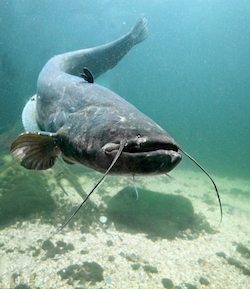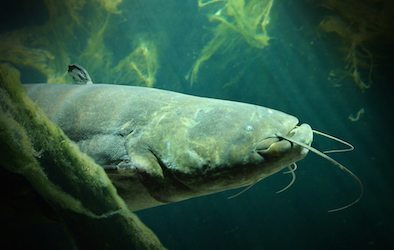Wels Catfish Fresh Water Monster


Picture of a catfish taken in Hracholusky Lake, Czech Republic. In Spain,the Wels are often caught over 150 lbs, and in abundance over 100 lbs
European Freshwater Killer
The Wels Catfish (Silurus glanis) isn’t as well known as it should be. It’s widespread, being found in most of Europe including the United Kingdom, down and across to Spain and all the way to the west end of Europe and into Asia.
It can be found in large warm lakes or in slow flowing rivers that are deep. This catfish also survives quite well in the colder weather of the northern temperate zone although they won’t grow nearly as large.
Although this monster catfish is a bottom feeder, it will quickly head to the surface to investigate possible prey.
Wels Catfish Features and Size
The Wels Catfish has hundreds of needle-shaped teeth along the bottom and top of it’s mouth. These teeth are not long, resembling course sandpaper. However a large fish could easily inflict considerable pain and draw blood if it were to clamp onto your leg, arm or any other body part.
- The Wels Catfish has two long barbels on the upper jaw
- The lower jaw has four barbels
- It’s anal fin is large and continues down from the anal fin to the caudal fin with the dorsal fin further forward than in most fish
- The Wels Catfish is black on the top when located in water that’s clear and brown when located in murky water
- It’s belly is yellow to white
- It has a slippery skin that’s free from scales as is the case with all catfish
The largest Wels Catfish ever caught is up for argument. Historical records point to catfish as large as 551 pounds/250 kg or as long as 10 feet. However, there is some doubt.
Wels Catfish caught in the southern end of their distribution reach over 150 pounds and are quite common at this size.
The Wels Catfish can live for 80 years.
The Wels Catfish Killer Myth
Since historical records began in Europe there’s been reports of very large catfish attacking and killing people.
Sizes of these fish range from those capable of swallowing babies and small children to full-size adults. These accounts are far from scientific.
Adding to this legend, modern newspapers claim that people have been attacked by the Wels Catfish, although there haven’t been reports of anyone being killed.
The most recent reports of human attacks were on people found to be swimming in the area where the Wels Catfish was spawning.
- It’s very protective of its eggs, staying around until the eggs hatch. The female laying as many as 300,000 eggs. At first, it appears as though the Wels Catfish only attacks people to defend itself or its young.
The Reality Behind the Myth
Despite a lot of ‘so called’ reference sites, the Wels Catfish can easily add 10 pounds each year.
In the Ebro River, Spain, the Wels is often caught over 150 pounds and fish over 100 pounds are in abundance.
The fish are protected and must be released after being caught leaving them to grow larger.
These larger fish are voracious feeders easily capable of consuming a small child or baby.
They have more than enough strength to pull a person under the water and drown them.
It’s estimated that a Wels Catfish is large enough to exhort sufficient force to pull a man underwater needing no more than 30 pounds of force.
Swimming in water where large Wels Catfish are present is not recommended. These fish will attack anything capable of fitting in their mouth.



